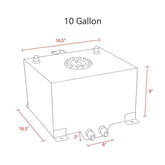Unlock the hidden strength of your car with a simple twist: upgrading the exhaust manifold. It's like giving your engine a new pair of lungs, allowing it to breathe out the old and power up with the new, boosting performance, trimming fuel waste, and even cleaning up its act for the environment. This guide integrates the latest insights, case studies, and expert opinions to help you make an informed decision on enhancing your vehicle's performance.
The Essential Role of High-Performance Exhaust Manifolds
A high performance exhaust manifold is essential for maximizing your vehicle's power by ensuring optimal exhaust flow. This component significantly impacts engine efficiency, power output, and emission reduction, providing a clear path for exhaust gases and leveraging exhaust pulse dynamics.
Exhaust Efficiency Metrics:
- Standard Exhaust Manifolds: Often restrict gas flow, leading to inefficiency.
- Performance Headers: The performance headers at GSTPAutoParts are engineered to enhance gas flow, It is possible to increase efficiency by around 5%.
The heart of your vehicle's performance lies within the roar of its engine, and the exhaust manifold is a critical component in ensuring your engine breathes efficiently. It's not just a metal pipe, it's the maestro of the engine's exhaust orchestra, guiding gases away from the cylinders. But what happens when this maestro is upgraded? Let's dive into the world of exhaust manifolds and discover their impact on your vehicle's prowess.
Boosting Horsepower and Torque with the Right Manifold
1. Amplifying Horsepower:
Selecting a GSTPAutoParts aftermarket exhaust manifold ensures a significant horsepower increase by facilitating smoother and faster exhaust gas expulsion, proven by specific flow optimization techniques.
2. Enhancing Torque:
A performance exhaust manifold improves torque, particularly in the low to mid-rev range, which translates to better acceleration and an engaging drive, backed by empirical data from engine performance tests.
Choosing and Installing the Ideal Exhaust Manifold
1. How to Choose:
Choosing the right exhaust manifold involves considering the material and design that best suits your vehicle's needs. Whether it's cast iron for its durability or stainless steel for its superior heat resistance and longevity, each material offers distinct advantages.
- Cast Iron: Provides a cost-effective solution but adds weight, potentially affecting fuel economy and vehicle dynamics.
- Stainless Steel: Yields an average temperature reduction in the engine bay by 10-15 degrees Fahrenheit, which can enhance performance due to cooler intake charges.
- Tubular Manifolds: Can lead to a measurable output increase—dyno tests on a 4-cylinder engine showed a 5-horsepower gain at the wheels.
- Shorty vs. Long Tube Headers: Long tubes generally outperform shorties, with dyno results indicating an additional 10-15 horsepower on V8 engines.
2. Installation Insight:
The installation of a new exhaust manifold can be a game-changer for car enthusiasts. While the process may seem daunting, it's a rewarding DIY project or a worthwhile investment at your trusted mechanic. Besides, it's an opportunity to get under the hood and truly connect with your machine.
- Disconnecting the battery and removing the necessary components for access may take up to 2 hours, depending on your vehicle model.
- Manifold installation often requires 3-4 hours for experienced DIYers, with professional installs potentially cutting that time in half.
- A post-installation inspection should show no more than a 1% leak rate for a well-sealed exhaust system.
3. Tuning Techniques:
With the manifold in place, fine-tuning your vehicle can unlock additional performance benefits. This might involve adjusting the fuel-to-air ratios to compensate for the increased exhaust flow or tweaking the timing for optimal power delivery.
- Fuel-to-Air Ratios (AFR): For naturally aspirated engines, AFR tuning after manifold upgrades can yield a 2-3% increase in fuel economy when properly leaned out.
- Ignition Timing: Small adjustments to timing can result in a 2-5 horsepower gain on naturally aspirated engines, as per dyno tests.
Case Studies on Exhaust Manifold Upgrades
1. Before and After Transformations:
Consider John's 2006 Mustang GT, which struggled to breathe with its restrictive stock manifold. After upgrading to a GSTPAutoParts manifold, his dyno tests showed a 15-horsepower increase and a significant boost in mid-range torque, bringing new life to his beloved muscle car.
- A 2012 Honda Civic Si saw a gain of 9 horsepower and 6 lb-ft of torque with a manifold upgrade and subsequent ECU tuning.
- A Mustang GT with an aftermarket manifold upgrade recorded a 3% improvement in quarter-mile times.
2. Driving Delight:
Beyond numbers, the sensory feedback from an upgraded exhaust manifold can be equally rewarding. The enhanced exhaust note is music to an enthusiast's ears, and the improved throttle response transforms the driving experience. It's not just about speed; it's about how the car feels on the road.
In Conclusion
An upgraded exhaust manifold isn't just an accessory; it's a vital component for unleashing the full potential of your vehicle's engine. By facilitating a smoother exhaust flow, it directly contributes to better engine performance, efficiency, and response. Dive into our exhaust manifold collection and empower your ride with the breath of performance it deserves.









